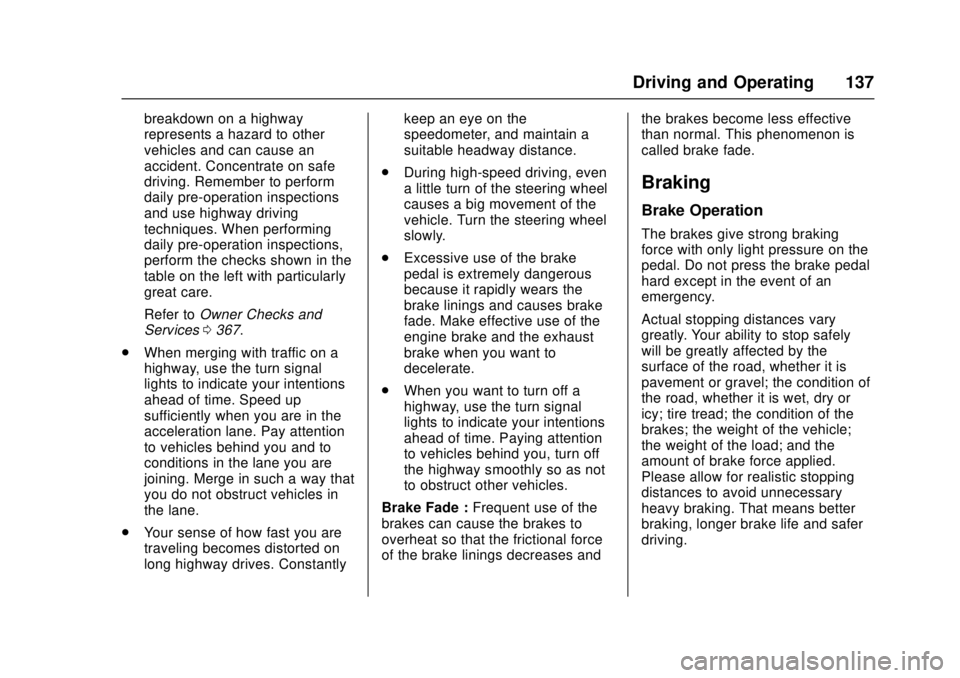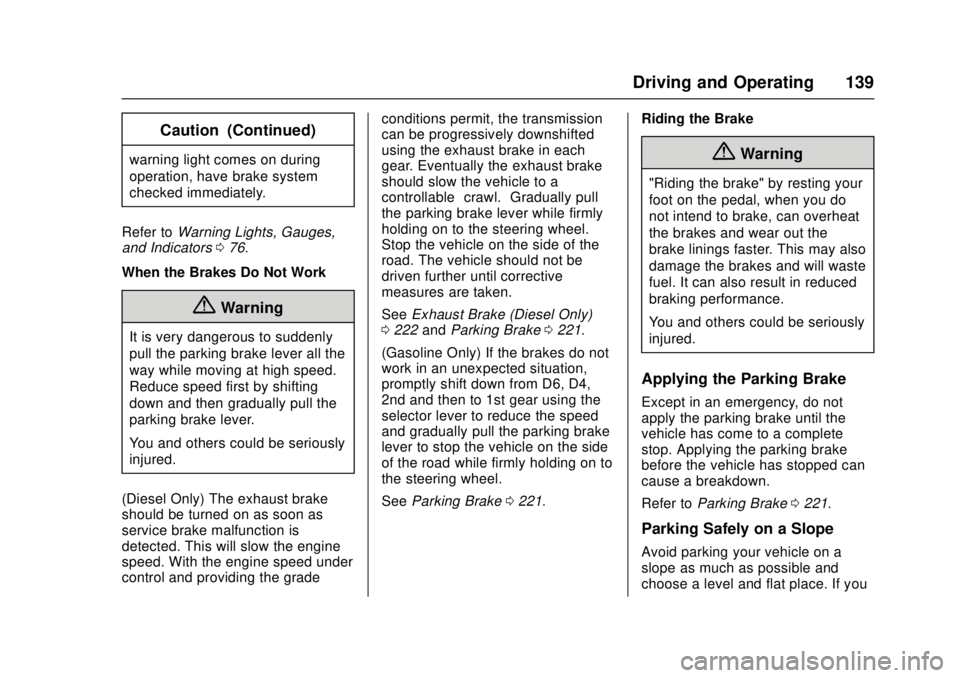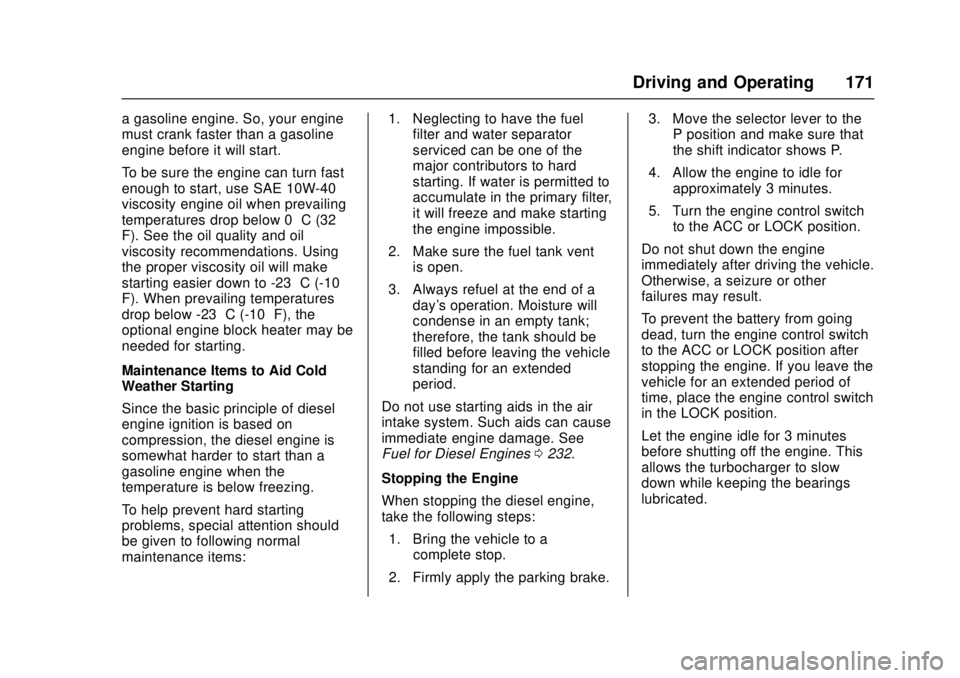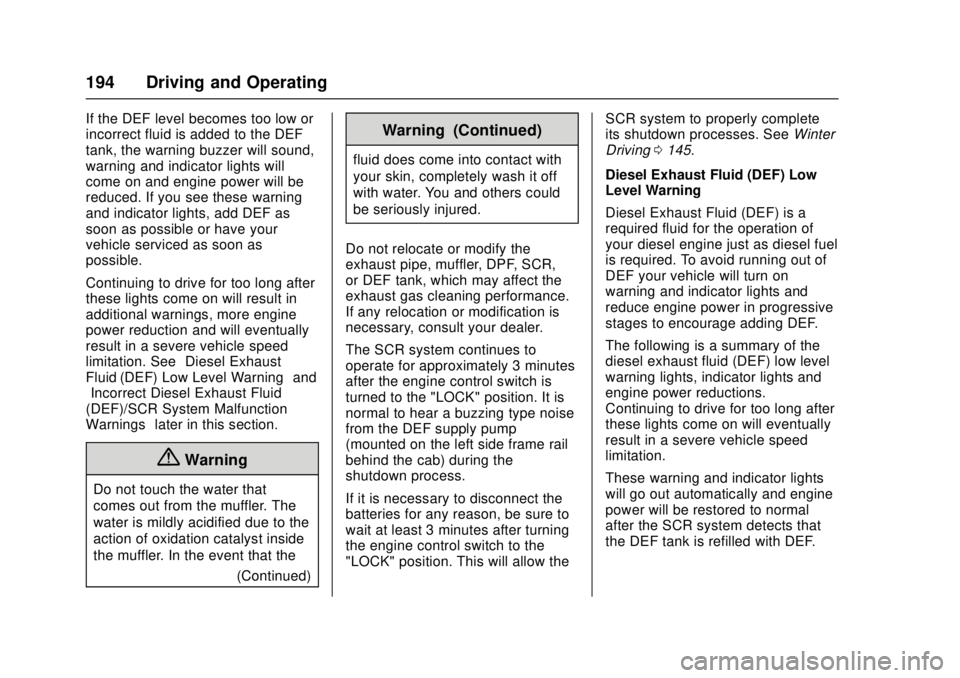service CHEVROLET LOW CAB FORWARD 2017 Owner's Guide
[x] Cancel search | Manufacturer: CHEVROLET, Model Year: 2017, Model line: LOW CAB FORWARD, Model: CHEVROLET LOW CAB FORWARD 2017Pages: 414, PDF Size: 7.97 MB
Page 138 of 414

Chevrolet Low Cab Forward Owner Manual (GMNA-Localizing-U.S.-
10716700) - 2017 - crc - 12/6/16
Driving and Operating 137
breakdown on a highway
represents a hazard to other
vehicles and can cause an
accident. Concentrate on safe
driving. Remember to perform
daily pre-operation inspections
and use highway driving
techniques. When performing
daily pre-operation inspections,
perform the checks shown in the
table on the left with particularly
great care.
Refer toOwner Checks and
Services 0367.
. When merging with traffic on a
highway, use the turn signal
lights to indicate your intentions
ahead of time. Speed up
sufficiently when you are in the
acceleration lane. Pay attention
to vehicles behind you and to
conditions in the lane you are
joining. Merge in such a way that
you do not obstruct vehicles in
the lane.
. Your sense of how fast you are
traveling becomes distorted on
long highway drives. Constantly keep an eye on the
speedometer, and maintain a
suitable headway distance.
. During high-speed driving, even
a little turn of the steering wheel
causes a big movement of the
vehicle. Turn the steering wheel
slowly.
. Excessive use of the brake
pedal is extremely dangerous
because it rapidly wears the
brake linings and causes brake
fade. Make effective use of the
engine brake and the exhaust
brake when you want to
decelerate.
. When you want to turn off a
highway, use the turn signal
lights to indicate your intentions
ahead of time. Paying attention
to vehicles behind you, turn off
the highway smoothly so as not
to obstruct other vehicles.
Brake Fade : Frequent use of the
brakes can cause the brakes to
overheat so that the frictional force
of the brake linings decreases and the brakes become less effective
than normal. This phenomenon is
called brake fade.
Braking
Brake Operation
The brakes give strong braking
force with only light pressure on the
pedal. Do not press the brake pedal
hard except in the event of an
emergency.
Actual stopping distances vary
greatly. Your ability to stop safely
will be greatly affected by the
surface of the road, whether it is
pavement or gravel; the condition of
the road, whether it is wet, dry or
icy; tire tread; the condition of the
brakes; the weight of the vehicle;
the weight of the load; and the
amount of brake force applied.
Please allow for realistic stopping
distances to avoid unnecessary
heavy braking. That means better
braking, longer brake life and safer
driving.
Page 140 of 414

Chevrolet Low Cab Forward Owner Manual (GMNA-Localizing-U.S.-
10716700) - 2017 - crc - 12/6/16
Driving and Operating 139
Caution (Continued)
warning light comes on during
operation, have brake system
checked immediately.
Refer to Warning Lights, Gauges,
and Indicators 076.
When the Brakes Do Not Work
{Warning
It is very dangerous to suddenly
pull the parking brake lever all the
way while moving at high speed.
Reduce speed first by shifting
down and then gradually pull the
parking brake lever.
You and others could be seriously
injured.
(Diesel Only) The exhaust brake
should be turned on as soon as
service brake malfunction is
detected. This will slow the engine
speed. With the engine speed under
control and providing the grade conditions permit, the transmission
can be progressively downshifted
using the exhaust brake in each
gear. Eventually the exhaust brake
should slow the vehicle to a
controllable
“crawl.”Gradually pull
the parking brake lever while firmly
holding on to the steering wheel.
Stop the vehicle on the side of the
road. The vehicle should not be
driven further until corrective
measures are taken.
See Exhaust Brake (Diesel Only)
0 222 andParking Brake 0221.
(Gasoline Only) If the brakes do not
work in an unexpected situation,
promptly shift down from D6, D4,
2nd and then to 1st gear using the
selector lever to reduce the speed
and gradually pull the parking brake
lever to stop the vehicle on the side
of the road while firmly holding on to
the steering wheel.
See Parking Brake 0221. Riding the Brake
{Warning
"Riding the brake" by resting your
foot on the pedal, when you do
not intend to brake, can overheat
the brakes and wear out the
brake linings faster. This may also
damage the brakes and will waste
fuel. It can also result in reduced
braking performance.
You and others could be seriously
injured.
Applying the Parking Brake
Except in an emergency, do not
apply the parking brake until the
vehicle has come to a complete
stop. Applying the parking brake
before the vehicle has stopped can
cause a breakdown.
Refer to
Parking Brake 0221.
Parking Safely on a Slope
Avoid parking your vehicle on a
slope as much as possible and
choose a level and flat place. If you
Page 143 of 414

Chevrolet Low Cab Forward Owner Manual (GMNA-Localizing-U.S.-
10716700) - 2017 - crc - 12/6/16
142 Driving and Operating
Frequent use of the foot brakes can
cause vapor lock and brake fade,
resulting in reduced brake
effectiveness.
Brake Fade :Frequent use of the
brakes can cause the brakes to
overheat so that the frictional force
of the brake linings decreases and
the brakes become less effective
than normal. This phenomenon is
called brake fade.
Vapor Lock : If the brakes overheat
due to frequent use, the heat can
cause the brake fluid to boil so that
air bubbles are created in the brake
fluid. Pressing the brake pedal
simply compresses the air bubbles;
pressure is not transmitted to the
wheel cylinders, so the brakes'
effectiveness sharply deteriorates.
This phenomenon is called
vapor lock.
Even so, you should be very careful
when using engine braking in a low
gear because the engine is likely to
over-rev.
See Exhaust Brake (Diesel Only)
0 222 andSelector Lever 0214. On diesel vehicles, do not adjust the
exhaust brake valve.
The engine should never be allowed
to exceed the governed speed.
Supplement the exhaust brake with
vehicle service brakes intermittently
and/or shift to higher transmission
gear to prevent engine overspeed.
A rule of thumb for gear selection is
that the vehicle should be driven
down a grade in the same gear that
would be used to climb that grade.
{Warning
To reduce the risk of personal
injury, before going down a steep
or long grade, reduce speed, turn
on the exhaust brake and shift the
transmission to the next lower
gear. This will help control your
speed. Do not hold the brake
pedal down too long or too often
while going down a steep or long
grade. This could cause the
brakes to get hot and not to work
as well. As a result, the truck will
(Continued)
Warning (Continued)
not slow down at the usual rate.
Failure to take these steps could
result in loss of vehicle control.
You and others could be seriously
injured.
Brake Effectiveness When the
Vehicle Has Been Driven on a
Flooded Road or Washed
{Warning
When the vehicle is driven on a
flooded road, parked on a flooded
road or washed, water can get
into the brakes and reduce their
effectiveness. If the brakes do not
work well afterward, drive slowly
and gently press the brake pedal
several times until the brakes dry
out and start working normally.
Always do this after driving
through water or washing the
vehicle to help reduce the risk of(Continued)
Page 161 of 414

Chevrolet Low Cab Forward Owner Manual (GMNA-Localizing-U.S.-
10716700) - 2017 - crc - 12/6/16
160 Driving and Operating
SymptomCauseCorrective Action Reference
Loud or abnormal
noises From the
transmission
Insufficient
transmission oil
Add oilSee
Automatic
Transmission Fluid
0 260
Transmission inner
components faulty
4-
From differential Insufficient differential
gear oil
Add oilSee
Rear Axle
(Gear Oil Viscosity
Chart) 0283 or
Rear Axle (Oil
Level Check) 0283
Differential inner
components faulty
4-
From the
suspension Spring pins, shackles,
or stoppers worn
4-
From the driveshaft Poor lubrication in each
component
Lubricate themSee
Owner Checks
and Services 0367
Splines or bearings worn
4-
Page 166 of 414

Chevrolet Low Cab Forward Owner Manual (GMNA-Localizing-U.S.-
10716700) - 2017 - crc - 12/6/16
Driving and Operating 165
Turn the key against spring
pressure to energize the starter.
When key is released, spring
pressure returns it to the ON
position. Release the key as soon
as the engine has started.
If the key cannot be turned from the
LOCK position to the ON position,
lightly move the steering wheel
clockwise and counterclockwise
while trying to turn the key.
Starting and Stopping the
Vehicle (Gasoline Only)
Check around the Vehicle before
Starting the Engine
Proper care and operation will not
only extend the service life of your
vehicle but also improve fuel
economy.
Before pulling away, perform a
thorough safety check, making sure
there are no children or obstructions
around the vehicle. Take off the
chocks after confirming that the
parking brake is securely applied.Sit behind the wheel, adjust the seat
position, and buckle up the seat
belt. The passengers are also
required to buckle up the seat belts.
Adjust the positions of the steering
wheel and mirrors. Lock the doors.
Turn the power of the dome light or
accessories OFF before starting the
engine. See
Seat Position 044,
Seat Belts 049, Steering Wheel
Adjustment 072, and Mirrors039.
Keep the Floor Around the
Driver's Seat Clean and Tidy{Warning
It is extremely dangerous to have
empty cans, empty bottles or
other items rolling around on the
floor because they could get
trapped under the brake pedal
and prevent brake application.
For proper pedal operation, it is
also essential to lay floor mats
properly. Incorrectly installed floor
mats would hinder free movement
of the pedals. (Continued)
Warning (Continued)
Do not use the dashboard pocket
or the top of the dashboard as a
place to put items that could roll,
which could interfere with your
driving. You and others could be
seriously injured.
Choose Your Footwear Suitable
for Driving
{Warning
Choose footwear that ensures
proper operation of pedals when
driving the vehicle. Use of
footwear unsuitable for driving
may cause an accident.
Checks Before Operating
Allow the engine to warm up before
driving. While the engine is warming
up, the following checks should
be made: 1. Observe the engine oil pressure warning light. The
light should go out when the
Page 169 of 414

Chevrolet Low Cab Forward Owner Manual (GMNA-Localizing-U.S.-
10716700) - 2017 - crc - 12/6/16
168 Driving and Operating
flammable material, such as
grass, waste paper, oil, or old
tires near the exhaust pipe.
Cold Weather Starting
If you plan ahead for cold weather,
starting and driving your vehicle
should be no problem.
Oil gets thicker as it gets colder,
which slows down the engine
cranking speed.
To be sure the engine can turn fast
enough to start, use SAE 0W-30
viscosity engine oil when prevailing
temperatures drop below 0 °C (32 °
F). See the oil quality and oil
viscosity recommendations. Using
the proper viscosity oil will make
starting easier down to -23 °C (-10 °
F). When prevailing temperatures
drop below -23 °C (-10 °F), the
optional engine block heater may be
needed for starting.
Stopping the Engine
When stopping the gasoline engine,
take the following steps: 1. Bring the vehicle to a complete stop. 2. Firmly apply the parking brake.
3. Move the selector lever to the
P position and make sure that
the shift indicator shows P.
4. Allow the engine to idle for approximately 3 minutes.
5. Turn the engine control switch to the ACC or LOCK position.
To prevent the battery from going
dead, turn the engine control switch
to the ACC or LOCK position after
stopping the engine. If you leave the
vehicle for an extended period of
time, place the engine control switch
in the LOCK position.
If the Vehicle Has Not Been Used
for a Long Period
If the vehicle is to be placed in
storage for a prolonged period of
time, certain precautions must be
taken to prevent deterioration. See
your authorized dealer for more
detailed information.
. Before using a vehicle that has
not been driven for a long
period, check the engine and
transmission for oil leakage, and make sure the oil is at the
required levels. If there is
insufficient oil, it will not
adequately reach and lubricate
components, and a breakdown
will result.
. Start the engine and allow it to
idle for at least 5 minutes. Check
for abnormal noises.
. For instructions on warming up
the engine, refer to “Starting the
Engine” previously in this
section.
Starting and Stopping the
Vehicle (Diesel Only)
Check around the Vehicle before
Starting the Engine
Proper care and operation will not
only extend the service life of your
vehicle but also improve fuel
economy.
Before pulling away, perform a
thorough safety check, making sure
there are no children or obstructions
around the vehicle. Take off the
chocks after confirming that the
parking brake is securely applied.
Page 172 of 414

Chevrolet Low Cab Forward Owner Manual (GMNA-Localizing-U.S.-
10716700) - 2017 - crc - 12/6/16
Driving and Operating 171
a gasoline engine. So, your engine
must crank faster than a gasoline
engine before it will start.
To be sure the engine can turn fast
enough to start, use SAE 10W-40
viscosity engine oil when prevailing
temperatures drop below 0 °C (32 °
F). See the oil quality and oil
viscosity recommendations. Using
the proper viscosity oil will make
starting easier down to -23 °C (-10 °
F). When prevailing temperatures
drop below -23 °C (-10 °F), the
optional engine block heater may be
needed for starting.
Maintenance Items to Aid Cold
Weather Starting
Since the basic principle of diesel
engine ignition is based on
compression, the diesel engine is
somewhat harder to start than a
gasoline engine when the
temperature is below freezing.
To help prevent hard starting
problems, special attention should
be given to following normal
maintenance items:1. Neglecting to have the fuel
filter and water separator
serviced can be one of the
major contributors to hard
starting. If water is permitted to
accumulate in the primary filter,
it will freeze and make starting
the engine impossible.
2. Make sure the fuel tank vent is open.
3. Always refuel at the end of a day's operation. Moisture will
condense in an empty tank;
therefore, the tank should be
filled before leaving the vehicle
standing for an extended
period.
Do not use starting aids in the air
intake system. Such aids can cause
immediate engine damage. See
Fuel for Diesel Engines 0232.
Stopping the Engine
When stopping the diesel engine,
take the following steps: 1. Bring the vehicle to a complete stop.
2. Firmly apply the parking brake. 3. Move the selector lever to the
P position and make sure that
the shift indicator shows P.
4. Allow the engine to idle for approximately 3 minutes.
5. Turn the engine control switch to the ACC or LOCK position.
Do not shut down the engine
immediately after driving the vehicle.
Otherwise, a seizure or other
failures may result.
To prevent the battery from going
dead, turn the engine control switch
to the ACC or LOCK position after
stopping the engine. If you leave the
vehicle for an extended period of
time, place the engine control switch
in the LOCK position.
Let the engine idle for 3 minutes
before shutting off the engine. This
allows the turbocharger to slow
down while keeping the bearings
lubricated.
Page 192 of 414

Chevrolet Low Cab Forward Owner Manual (GMNA-Localizing-U.S.-
10716700) - 2017 - crc - 12/6/16
Driving and Operating 191
.Any substance other than the
DEF may cause a breakdown to
the SCR system.
. Use the DEF handling
equipment made of correct
materials (Polyethylene or
Stainless-steel).
. Avoid contamination from using
dirty funnel for filling.
. If a fluid other than the specified
DEF is mistakenly added,
incorrect fluid may cause a
failure. Have it inspected and
serviced at a dealer immediately.
. Ammonia odor may be
generated when the DEF is
exposed to high temperature.
. Do not add DEF above the F
position on the level gauge. DEF
may leak from the breather hose
while driving. Also, the sensor
may be broken when DEF
freezes.
. Do not put your feet on or stand
on the DEF tank. The tank, pipe
or sensors may be damaged. .
After stopping the engine, a flow
sound may be heard from the
DEF tank or DEF supply pump.
This sound occurs as the DEF in
the piping is returning to the
tank, and does not indicate an
abnormality.
See Winter Driving 0145.
Adding DEF
1. Turn the engine control switch to the ACC or LOCK position
and make sure to stop the
engine.
2. Wipe off dust or dirt from around the filler port of the
DEF tank. 3. Turn and remove the filler cap.
4. Refill the tank up to the F
position in the level gauge on
the front face of the tank. The
DEF may overflow from the
filler port if it is added in excess
of the F position.
5. Tighten the cap after refilling is completed.
6. Wipe off DEF that is spilled at refilling.
{Warning
On occasion, you may notice an
odor when the DEF tank is
opened. Do not sniff the filler
port, etc.
When refilling the DEF tank:
Failure to follow the above
instructions could result in a fire
or a breakdown of the selective
catalytic reduction (SCR) system.
Do not dilute DEF with water.
(Continued)
Page 195 of 414

Chevrolet Low Cab Forward Owner Manual (GMNA-Localizing-U.S.-
10716700) - 2017 - crc - 12/6/16
194 Driving and Operating
If the DEF level becomes too low or
incorrect fluid is added to the DEF
tank, the warning buzzer will sound,
warning and indicator lights will
come on and engine power will be
reduced. If you see these warning
and indicator lights, add DEF as
soon as possible or have your
vehicle serviced as soon as
possible.
Continuing to drive for too long after
these lights come on will result in
additional warnings, more engine
power reduction and will eventually
result in a severe vehicle speed
limitation. See“Diesel Exhaust
Fluid (DEF) Low Level Warning” and
“Incorrect Diesel Exhaust Fluid
(DEF)/SCR System Malfunction
Warnings” later in this section.
{Warning
Do not touch the water that
comes out from the muffler. The
water is mildly acidified due to the
action of oxidation catalyst inside
the muffler. In the event that the
(Continued)
Warning (Continued)
fluid does come into contact with
your skin, completely wash it off
with water. You and others could
be seriously injured.
Do not relocate or modify the
exhaust pipe, muffler, DPF, SCR,
or DEF tank, which may affect the
exhaust gas cleaning performance.
If any relocation or modification is
necessary, consult your dealer.
The SCR system continues to
operate for approximately 3 minutes
after the engine control switch is
turned to the "LOCK" position. It is
normal to hear a buzzing type noise
from the DEF supply pump
(mounted on the left side frame rail
behind the cab) during the
shutdown process.
If it is necessary to disconnect the
batteries for any reason, be sure to
wait at least 3 minutes after turning
the engine control switch to the
"LOCK" position. This will allow the SCR system to properly complete
its shutdown processes. See
Winter
Driving 0145.
Diesel Exhaust Fluid (DEF) Low
Level Warning
Diesel Exhaust Fluid (DEF) is a
required fluid for the operation of
your diesel engine just as diesel fuel
is required. To avoid running out of
DEF your vehicle will turn on
warning and indicator lights and
reduce engine power in progressive
stages to encourage adding DEF.
The following is a summary of the
diesel exhaust fluid (DEF) low level
warning lights, indicator lights and
engine power reductions.
Continuing to drive for too long after
these lights come on will eventually
result in a severe vehicle speed
limitation.
These warning and indicator lights
will go out automatically and engine
power will be restored to normal
after the SCR system detects that
the DEF tank is refilled with DEF.
Page 198 of 414

Chevrolet Low Cab Forward Owner Manual (GMNA-Localizing-U.S.-
10716700) - 2017 - crc - 12/6/16
Driving and Operating 197
DEF Tank Level is Low/Empty (cont'd)
StageStage 1 Stage 2Stage 3Stage 4
CAUTION
This message indicates incorrect DEF or an SCR system malfunction. Immediately contact
your dealer to have your vehicle serviced *2
Remarks:
*1 –See Diesel Exhaust
Fluid (DEF).
*2 –See Incorrect Diesel Exhaust
Fluid (DEF) /SCR System
Malfunction Warnings.
*3 –The warning buzzer continues
to sound every 5 minutes.
*4 –The warning buzzer continues
to sound every 5 minutes and when
driving 8 km (5 miles) or more, the
buzzer changes its sound to
continuous beeping.
DEF tank low stages are as follows: Stage 1 :
When the remaining level
of DEF becomes excessively low
the DEF gauge will change color
from green to amber. In addition,
warning and indicator lights will
come on as shown in the table and
engine power will be reduced so the
vehicle speed will not exceed
89 km/h (55 MPH).
Stage 2 : If driving is continued
without adding DEF (approximately
320 km (200 miles)) the DEF gauge,
warning and indicator lights will
begin blinking. Again, engine power
will be reduced so the vehicle speed
will not exceed 56 km/h (35 MPH). Stage 3 :
If driving is continued until
the DEF tank is empty, the DEF
gauge will change color from amber
to red and the warning and indicator
lights will begin to blink faster.
Engine power will still be reduced so
the vehicle speed will not exceed
56 km/h (35 MPH). The vehicle
speed will be limited to
8 km/h (5 MPH) either when the
vehicle is stopped after driving
further on (approximately
8 km (5 miles)) or when the engine
is restarted.